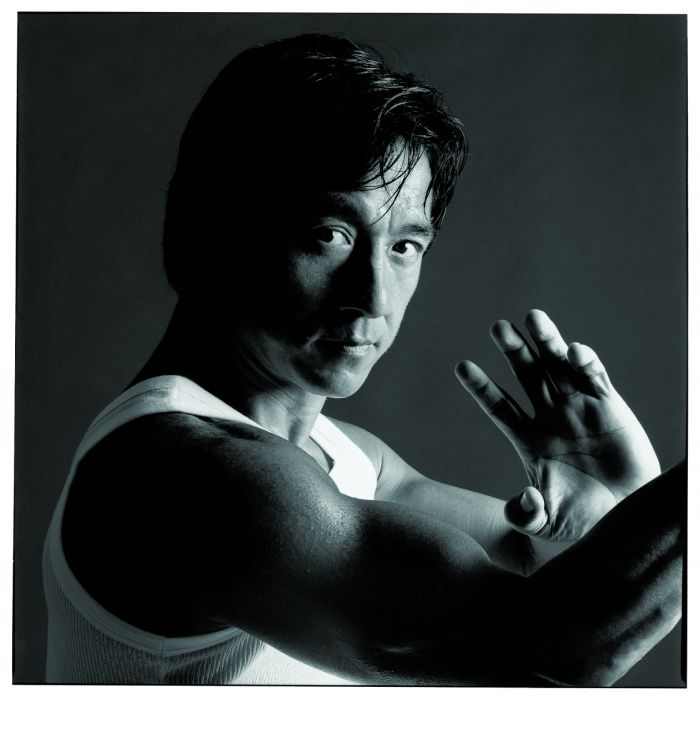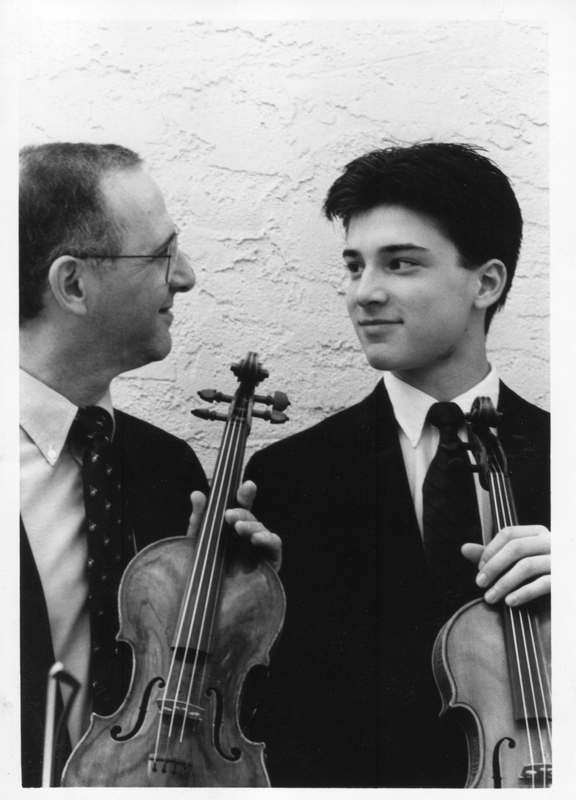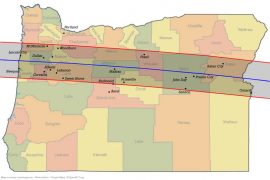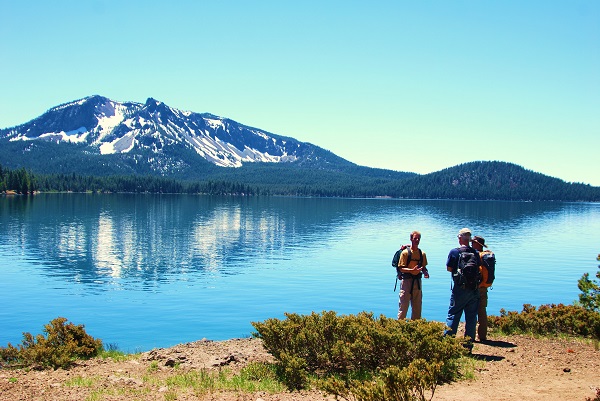Known as the “Avedon of Asia,” Russel Wong is among celebrity photographer royalty—Richard Avedon, Annie Leibovitz, Helmut Newton. Wong’s portfolio includes sixteen covers for Time magazine, landscapes sold by Christies, and lush publicity images for the Oscar-winning films, Crouching Tiger, Hidden Dragon and House of Flying Daggers.
Wong now brings his first U.S. Exhibit, “Russel Wong: The Big Picture” to Oregon, where he used to hop the fence at Hayward Field and sneak pictures of his track heroes—all to earn free Nikes. “Russel Wong: The Big Picture” runs through August 19 at Eugene’s Jordan Schnitzer Museum of Art.
You’ve chosen the University of Oregon once again, first as a 16-year-old finance major and “track nut” from Singapore, and now for your first U.S. exhibit. What does it mean to be back?
It feels like home, and where it all started for me. On this trip, the University gave me a pass into Hayward Field to shoot. Amazing! I lay there in the infield just soaking it in!
My love of running came from dad, in Singapore. He used to train us at the track. I knew nothing of Eugene, except that it had a great running tradition and was the home of Nike. One of my aims was to meet Mr. Bill Bowerman (legendary Oregon track coach and co-founder of Nike), so I snooped around and found out he was coaching a bunch of Olympians behind Hayward Field. I ran over on a Saturday morning, and there he was in his cowboy hat and a green raincoat. I introduced myself, and asked if he would help me bring my 10K time down. I had no idea I was talking to Mr. Nike. He asked me about Singapore, and was curious if I was on scholarship, to which I said no, just a regular kid who runs for free T-shirts. We met every Saturday, as he took me on and gave me my training schedules.
Let’s talk about that day in 1980 when, at just 19 years old, you shot the picture that launched your career.
My friend called me one morning and said the great middle-distance runner Sebastian Coe was giving a talk at Alton Baker Park. I jumped on my bike and rode across the river to this picnic shed. There I was with my cheap camera, a $20 flash, and a roll of Kodachrome. I waited for the moment Coe put the mic down. Then this amazing sunlight came streaming in from the left and I started shooting. I got his autograph, but was then led out. I decided to blow up the photos and put them on my dorm wall. Some guys told me to show them to Nike and I might get some free shoes. So off I went on my bike in the rain, of course, and my box of Kodachrome in my backpack to get some free shoes. Nike loved the shots, hung onto the slides and then brought me back to the warehouse and told me I could pick any pair of shoes I wanted.
You had no formal training. What was it about your photos that caught Nike’s attention?
I was surprised. My dad gave me that camera to send photos home of my university life, but it became a tool for me to photograph some of my track idols. My training was listening to what the people at Dot Dotson (a Eugene photo shop) had to say, or studying photos by Brian Lanker of the Eugene Register Guard. My motivation was more shoes. I realized that Nike liked the swoosh to be visible and sharp, and that’s when I learned about fast shutter speeds. I never had a motor drive, so I had to time my shots and get it right the first time.
You jokingly refer to your photograph of model Cindy Crawford as your sister. How did you go from “shooting sweaty men to shooting beautiful women”?
My fashion break was photographing the girls of the University of Oregon sororities. That was a no-brainer, and more fun than sweaty men round the track. I discovered fashion photography after seeing a Richard Avedon photo he shot for Versace. I finally found something I could create from scratch, a blank canvas. After college, during my two years in the Singapore service, I pursued fashion photography and got my first fashion cover. I felt I needed formal training, so I went to the Art Center College of Design in Pasadena, while also working the modeling agencies. I took a semester in Milan to get the soul of the fashion scene. Then I went back to LA, and found my whole style had changed. I started booking my first jobs for the LA Times Magazine celebrity spreads.
Actress Joan Chen said you walked right up to her in a hotel bar and asked to photograph her—and that she actually called you. This happens over and over again for you. What’s your secret?
Joan Chen was the biggest Asian star at that time, after The Last Emperor. I needed an Asian star for my first show in Singapore and so I left a card with her. I got into Time magazine because of the portrait I did of her for Twin Peaks. She is one of my closest friends I have in the business. I was never shy asking someone if I could shoot them. Don’t ask, don’t get. I realized I had to beef up the portfolio, and furthermore, I enjoyed working with these high profile people. I just told them, “I’m a broke student,” or “I’m starting out, can you help me?”
After LA, you go to NYC where you met iconic fashion photographers Antonio Lopez (known for his portraits of Jerry Hall and Grace Jones) and Art Kane (who photographed the Rolling Stones, Janis Joplin and Bob Dylan). Where did those connections lead?
Antonio Lopez was an amazing fashion illustrator and close friend of Karl Lagerfeld. He was giving a lesson in my school in LA and so I asked him for some feedback on my portfolio. He told me I had to move to New York to grow. He got me an interview with Art Kane, the fashion photographer. They offered me a job as Kane’s assistant, but it was too low paying and, more importantly, the guy in the studio told me not to do it, as I could work right away. Back to LA I went. That was the closest I got to assisting for anyone. Never made a coffee for anyone as an assistant or carried a light. I just wanted to work right off the bat.
Tell us about how your close friendship with actor Jackie Chan.
Growing up in Asia, Jackie Chan is it. Being part Cantonese myself and speaking the language, Jackie and I hit it off. The difference was, I brought the American style of marketing to the table. We shot some ads and the Time cover when his Rush Hour was a huge hit. Jackie has always been generous, and also very proud of being Asian, so working with him made me connect with my own roots as, until then, I was only shooting in the U.S. He helped me find a niche. There was no one in Asia shooting the biggest people in the whole Asian continent. The Hong Kong photographers shot the Hong Kong people, the Japanese photographers shot the Japanese people, and so on. I just wanted to shoot the most iconic people regardless of where they were. I saw what the great photographers shot in the U.S. and in Europe, and they seldom wandered into my territory—Asia.
I started placing these celebrities on covers so it was a win-win situation. We both got the cover. I was now cutting deals and being sort of their publicist. I felt like the bridge between the East and the West.
Now you’re also shooting landscapes. A recent Christie’s auction, Wong’s “Bamboo Forest” print sold for $40,000. As with your human subjects, do you already know what you want before you shoot?
I already know what I want even in the landscape shots, as I studied the Chinese paintings and know the feel I want. I do weather research, hike up mountains, and wait for hours with a coffee in -10C. I do this over and over again, as every time I go to that same spot it’s going to be a different shot. I also speak a lot to the locals and have them tell me secret places.
Your photography on Twitter reveals another passion—you’re a foodie. That must have come in handy when you appeared on No Reservations with your buddy Anthony Bourdain.
Every Singaporean is a foodie. I love food and need to eat so why not shoot it and talk to the chefs involved at the same time. I don’t cook though. I kid my friends and tell them in life, you are either the emperor or you serve the emperor. I choose the former as my last name Wong, in Chinese, means emperor!
I met Bourdain when I was assigned to do his publicity for No Reservations. We hit it off as he’s a no BS person and gets Asia. The food we like is honest food. My mum is an amazing cook and she comes from two great food cultures–Peranakan and Cantonese. Those are the recipes I shared with Tony. But in Oregon, I did load up on Dutch Babies.
In Singapore, you’re credited with igniting a hunger for collecting fine photography and for inspiring a new generation of talent. As a young man who had his heroes, how are you now giving back?
I give some master classes, talk at art school, kick these kids in the butt, and tell them they’ve got to know how to schmooze. It’s not all about exposure.
Your book, Russel Wong: Photographs 1980-2005 chronicles some amazing photo sessions. What are some of your memorable moments?
After waiting for two hours in studio to shoot young Robert Downey Jr., I get a call from him apologizing, asking, “Can you make breakfast for me?” I did, and we connected right away. He handed me a U2 tape and started dancing for my shot. While waiting for the test shot, he looked at me with a straight face and said, “Russel, you gotta hang out with me ‘cause I’m gonna be big!” We did, and he was right.
For the cover of Time magazine, I had this idea to shoot Jackie Chan sitting in the middle of a huge Hong Kong street to show he was king of the city, and to celebrate his Rush Hour movie success. After waiting for the rain to stop, we walked in the middle of the isle of the main road and made a dash with his chair to the center. He sat there with on-coming cars and said, “Don’t worry, they will hit me before they hit you!” That was Jackie.
What’s next from your camera lens?
I’m working on a Geisha book, documenting their lives in Kyoto. I am also working on a book for Pritzker Prize winner Japanese architect, Kenzo Tange, and a book on Bali. I still go every year to shoot the Tour de France, as I am a huge fan of the sport. It’s sweaty men in tights and landscape all rolled into one. My life has come full circle!










Thank you for sharing sueprb informations. Your site is so cool. I am impressed by the details that you have on this web site. It reveals how nicely you understand this subject. Bookmarked this website page, will come back for more articles. You, my pal, ROCK! I found simply the information I already searched everywhere and just couldn't come across. What an ideal site.